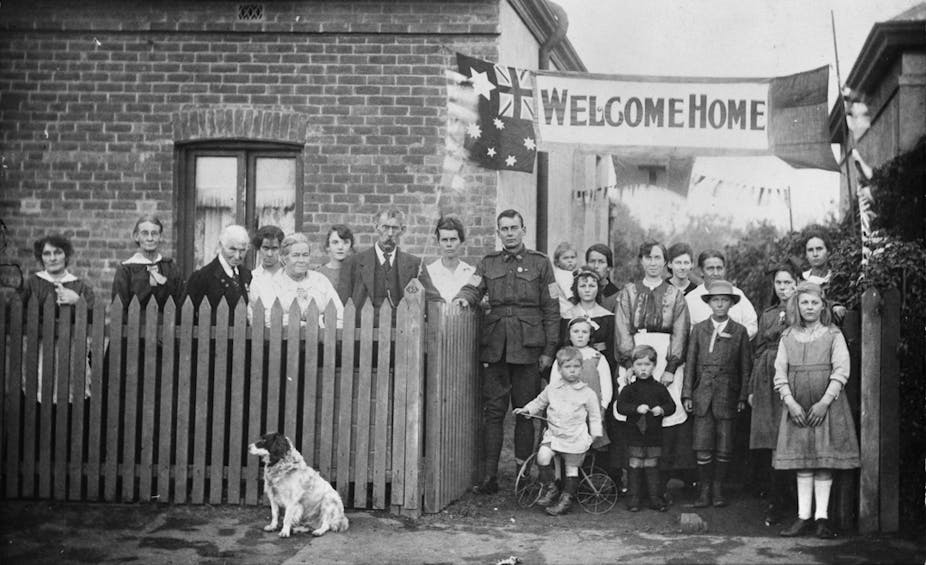The coming centenary of the first world war has already prompted some disquiet about a revival of the so-called “history wars”, given the significance of war to ideas of Australian national identity. In the public presentation of war history, soldiers’ personal letters, diaries and memoirs are fundamental to how we understand conflict and its effects.
These powerful sources offer deep insights into the war experiences of individual soldiers and nurses, and the impact on their families and communities. Yet their presentation can also serve popular myths about war and national identity. The exciting benefits of digitising such records – including a recent partnership between the State Library of New South Wales and News Corp – sit alongside broader concerns about the public uses of the wartime past.

A tradition of writing about the war from individual perspectives goes back at least to Australia’s official first world war historian C.E.W. Bean.
On one hand this reflects a democratic approach to the history of war. On the other, it reflects Bean’s belief that an Australian national character had been tested in the “crucible” of war. This required an emphasis on the qualities of the ordinary soldier. The idea that Australians shared common characteristics based on their British heritage and exposure to the Australian environment troubled later generations of scholars, who looked to the diversity of soldiers’ experiences to challenge such myths.
The first sustained studies of soldiers’ personal testimonies – Bill Gammage’s The Broken Years (1974) and Patsy Adam-Smith’s The Anzacs (1978) – reoriented popular and academic histories of Australia’s first world war.
Popular historians emphasise the seemingly direct access letters and diaries give us to the realities of the war. By contrast, academic historians have paid greater attention to soldier psychology, the effects of trauma, coping with the experience of killing, and relationships with home. This has exposed the long-term personal, emotional and psychological impacts of the war.
It has also opened up the diversity of war experience to scholars, leading them to challenge persistent ideas of a unifying national character.

The benefits of digitising soldiers’ letters and diaries lie in the greater access to knowledge this brings. Yet the selection and description of digitised materials is important.
News Corp Australia’s chief executive officer, Julian Clarke, described the recent project as a “commemoration”. Australians, he said, will see that “the first world war not only took a terrible human toll it was also critical in forming our national character”.
One might be anxious, then, about the uses to which the “raw thoughts and moving experiences” of Australians on the battlefields might be put. Certainly, in encouraging the use of this material in high schools across the country, News Corp’s “100 Years of Untold Stories” may fuel criticisms that such emphasis on the first world war is unbalancing the teaching of Australian history in secondary schools through a greater availability of resources on the Anzacs than on other important themes in Australian history.

Still, the powerful search capacities of digitised records open up the possibility of making connections to the past not easily achieved by amateur or professional historians previously. The 2007 release of some 375,000 digitised first world war service records by the National Archives of Australia can expose family historians to elements of the war seldom heard in public.
Here we see the anxieties of families at home, the impact of soldiers’ wounding and death, even the variety of crimes committed by some members of the Australian forces.
There are more and more records available: the often confronting Red Cross reports on the wounded and missing at the Australian War Memorial, postwar soldier settlement records in state archives, and the anticipated digitisation of veterans’ medical and pension files.
These resources will tell family historians much about the burdens of the war, so often carried by soldiers’ families. Wide access to such records can facilitate more complex family histories, and perhaps more complex approaches to a broader Australian history of the first world war.

Using personal stories to engage with the history of the war helps us expand our knowledge and challenge received narratives of the war. It also brings the dangers of displacing historical and critical understanding with an emphasis on nationalism and fellow-feeling.
Those digital archives that invite reflection and collaboration may be the most successful at engaging audiences in a more complex understanding of the wartime past. For this reason, the impulses of family history, and the searchability of digital archives, are critically important characteristics of successful digitisation projects.
We need to be able to trace our understanding of private testimonies back to those families who received, heard, kept and circulated them, and who themselves had experiences of war worthy of remembrance. In doing this, we begin to achieve the kind of understanding of war that these sources promise.

